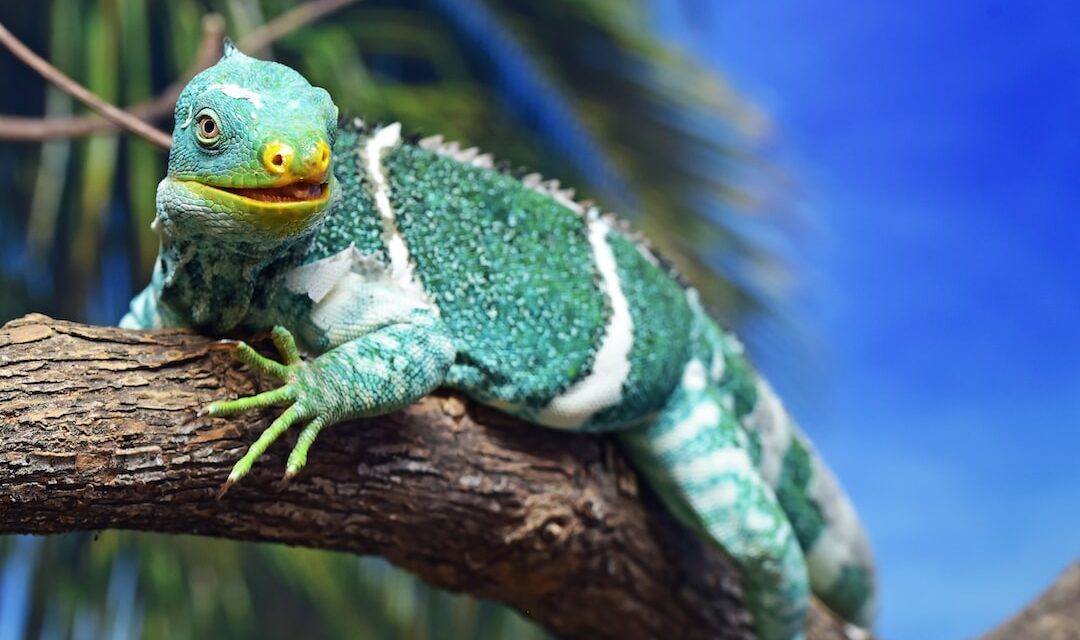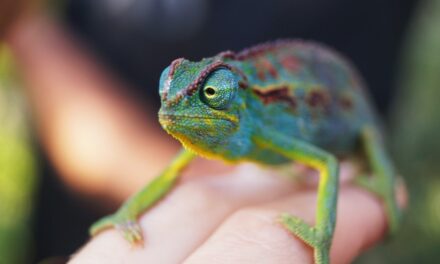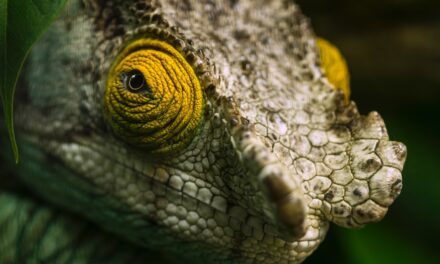Chameleon lizards are a fascinating group of reptiles known for their unique characteristics and adaptations. They belong to the family Chamaeleonidae, which includes over 200 species. Chameleon lizards are native to Africa, Madagascar, and parts of southern Europe, Asia, and the Middle East. They are known for their ability to change color, their prehensile tails, and their unique eyesight.
The history of chameleon lizards dates back millions of years. Fossil evidence suggests that they have been around for at least 65 million years. They have evolved over time to adapt to various environments and have developed remarkable survival strategies.
The Incredible Color Changing Abilities of Chameleon Lizards
One of the most remarkable features of chameleon lizards is their ability to change color. This ability is due to specialized cells called chromatophores in their skin. These cells contain pigments that can expand or contract, allowing the lizard to change its color.
Chameleon lizards change color for a variety of reasons. One reason is for camouflage, allowing them to blend in with their surroundings and avoid predators. They can match the colors and patterns of leaves, branches, or rocks, making them almost invisible to predators.
Another reason chameleon lizards change color is for communication. Males often change color to attract females during mating season or to establish dominance over other males. They can display vibrant colors such as bright greens, blues, or reds to signal their intentions.
Examples of chameleon lizards changing color can be seen in various species. For example, the panther chameleon (Furcifer pardalis) is known for its ability to display a wide range of colors, including bright reds, oranges, greens, and blues. The veiled chameleon (Chamaeleo calyptratus) can change its color to match its surroundings, making it difficult for predators to spot.
How Chameleon Lizards Use Their Prehensile Tails for Balance and Grip
Chameleon lizards have prehensile tails, which means they can grasp or hold onto objects. These tails are highly flexible and can be used for balance and grip. They are an important adaptation that allows chameleon lizards to navigate their environment with ease.
Chameleon lizards use their tails in a variety of ways. They can wrap their tails around branches or other objects to secure themselves while climbing. This helps them maintain balance and prevents them from falling.
The tails of chameleon lizards are also used for grip. They can curl their tails around branches or other surfaces, providing them with a strong hold. This allows them to move with agility and precision, even on slippery or uneven surfaces.
Examples of chameleon lizards using their tails can be observed in species such as the Jackson’s chameleon (Trioceros jacksonii). These lizards have long, prehensile tails that they use to anchor themselves while climbing trees or bushes. The tail acts as an extra limb, providing stability and support.
The Unique Eyesight of Chameleon Lizards: 360-Degree Vision and Independent Eye Movement
Chameleon lizards have unique eyesight that sets them apart from other reptiles. They have the ability to see in all directions, thanks to their 360-degree vision. This means they can see what is happening around them without having to turn their heads.
In addition to their wide field of vision, chameleon lizards also have the ability to move their eyes independently of each other. This allows them to focus on different objects simultaneously, giving them a distinct advantage when hunting or scanning their surroundings for potential threats.
The advantages of 360-degree vision and independent eye movement are numerous for chameleon lizards. It allows them to have a constant awareness of their environment, making it easier to spot predators or prey. They can also track moving objects more effectively, increasing their chances of successful hunting.
Examples of chameleon lizards using their eyesight can be seen in species such as the panther chameleon. These lizards can rotate their eyes in different directions, allowing them to scan their surroundings for potential threats or food. Their eyesight is a crucial adaptation that helps them survive in their natural habitats.
The Amazing Camouflage Techniques of Chameleon Lizards
Chameleon lizards are masters of camouflage. They have developed incredible techniques to blend in with their surroundings, making them almost invisible to predators or prey.
One of the main camouflage techniques used by chameleon lizards is called background matching. They can change their color and pattern to match the colors and patterns of their environment. This allows them to blend in seamlessly with leaves, branches, or rocks, making it difficult for predators to spot them.
Another camouflage technique used by chameleon lizards is called disruptive coloration. They can display bold patterns or markings that break up their body shape, making it harder for predators to recognize them as prey.
The advantages of camouflage for chameleon lizards are significant. It allows them to avoid predation by blending in with their surroundings and becoming virtually invisible. It also helps them sneak up on prey more effectively, increasing their chances of a successful hunt.
Examples of chameleon lizards blending in with their surroundings can be observed in species such as the leaf chameleon (Brookesia spp.). These lizards have the ability to change their color and pattern to match the leaves they are sitting on, making them almost indistinguishable from their environment.
The Role of Chameleon Lizards in Their Ecosystems
Chameleon lizards play an important role in their ecosystems. As predators, they help control populations of insects and other small invertebrates. They are also prey for larger predators, contributing to the food chain.
Chameleon lizards have a direct impact on their ecosystems through their feeding habits. They primarily feed on insects, such as crickets, grasshoppers, and beetles. By controlling the population of these insects, they help maintain the balance of their ecosystems.
In addition to their role as predators, chameleon lizards also contribute to seed dispersal. They consume fruits and berries, and the undigested seeds are passed through their digestive system and deposited in different locations. This helps spread plant species and promotes biodiversity.
The importance of chameleon lizards in their ecosystems cannot be overstated. They are an integral part of the food chain and help maintain the balance of their habitats. Their presence is crucial for the overall health and stability of their ecosystems.
The Different Species of Chameleon Lizards and Their Characteristics
There are over 200 species of chameleon lizards, each with its own unique characteristics. Some of the most well-known species include the panther chameleon, veiled chameleon, Jackson’s chameleon, and the pygmy chameleon.
The panther chameleon (Furcifer pardalis) is native to Madagascar and is known for its ability to display a wide range of colors. Males can reach lengths of up to 20 inches and have a lifespan of 5-7 years. They are arboreal and spend most of their time in trees.
The veiled chameleon (Chamaeleo calyptratus) is native to Yemen and Saudi Arabia. It is named for the large casque on its head, which resembles a veil. Males can reach lengths of up to 24 inches and have a lifespan of 5-7 years. They are also arboreal and have a unique ability to change color based on their mood or environment.
Jackson’s chameleon (Trioceros jacksonii) is native to East Africa and is known for its three horns on its head. Males can reach lengths of up to 14 inches and have a lifespan of 5-10 years. They are arboreal and can change color to match their surroundings.
The pygmy chameleon (Rhampholeon spp.) is native to East Africa and is one of the smallest species of chameleon lizards. They typically reach lengths of 2-3 inches and have a lifespan of 2-3 years. They are arboreal and have a unique ability to change color based on temperature and light conditions.
Each species of chameleon lizard has its own unique characteristics and adaptations that allow it to survive in its specific habitat.
The Adaptations of Chameleon Lizards for Survival in Different Environments
Chameleon lizards have evolved a range of adaptations that allow them to survive in different environments. These adaptations include their ability to change color, their prehensile tails, their unique eyesight, and their camouflage techniques.
The ability to change color is a crucial adaptation for chameleon lizards. It allows them to blend in with their surroundings, making it easier to avoid predation or sneak up on prey. This adaptation is particularly important for species that live in densely vegetated areas or among rocks and branches.
The prehensile tails of chameleon lizards are another important adaptation. They provide balance and grip, allowing the lizards to navigate their environment with ease. This adaptation is particularly useful for arboreal species that spend most of their time in trees.
Chameleon lizards’ unique eyesight is also an important adaptation for survival. Their 360-degree vision allows them to have a constant awareness of their surroundings, making it easier to spot predators or prey. The ability to move their eyes independently of each other gives them a distinct advantage when hunting or scanning their environment.
Camouflage techniques are another crucial adaptation for chameleon lizards. The ability to change color and pattern allows them to blend in with their surroundings, making it difficult for predators to spot them. This adaptation is particularly important for species that live in areas with a high density of predators or prey.
The adaptations of chameleon lizards are essential for their survival in different environments. They have evolved over millions of years to become highly specialized and efficient predators.
The Reproduction and Life Cycle of Chameleon Lizards
Chameleon lizards have unique reproductive strategies and life cycles. Most species are oviparous, meaning they lay eggs, but there are a few species that give birth to live young.
The mating process of chameleon lizards is often preceded by elaborate courtship displays. Males will display vibrant colors, puff up their bodies, and perform various movements to attract females. Once a female is receptive, mating occurs, and she will lay a clutch of eggs.
The incubation period for chameleon lizard eggs varies depending on the species and environmental conditions. It can range from a few weeks to several months. Once the eggs hatch, the young lizards are fully independent and must fend for themselves.
The lifespan of chameleon lizards varies depending on the species. Some species have relatively short lifespans of 2-3 years, while others can live up to 10 years or more.
Reproduction and the life cycle of chameleon lizards are crucial for their survival as a species. The ability to reproduce and produce offspring ensures the continuation of their population and allows them to adapt to changing environmental conditions.
Threats to Chameleon Lizards and Conservation Efforts to Protect Them
Chameleon lizards face numerous threats in their natural habitats. Habitat loss due to deforestation, urbanization, and agricultural expansion is one of the biggest threats. This destroys their natural habitats and reduces their available food sources.
Illegal pet trade is another significant threat to chameleon lizards. They are often captured and sold as exotic pets, leading to population declines in the wild. The demand for chameleon lizards as pets has increased in recent years, putting additional pressure on their populations.
Climate change is also a threat to chameleon lizards. Changes in temperature and precipitation patterns can disrupt their natural habitats and affect their ability to find food and reproduce.
Conservation efforts are underway to protect chameleon lizards and their habitats. These efforts include the establishment of protected areas, such as national parks and reserves, where chameleon lizards can thrive without disturbance. Education and awareness campaigns are also important in promoting the conservation of these unique reptiles.
The conservation of chameleon lizards is crucial for their survival and the overall health of their ecosystems. Protecting their habitats and reducing the demand for them as pets are essential steps in ensuring their long-term survival.
Chameleon lizards are truly remarkable creatures with a range of unique characteristics and adaptations. Their ability to change color, use their prehensile tails, and have 360-degree vision sets them apart from other reptiles. They play an important role in their ecosystems as predators and seed dispersers.
The different species of chameleon lizards each have their own distinct characteristics and adaptations that allow them to survive in different environments. Their reproductive strategies and life cycles ensure the continuation of their populations.
However, chameleon lizards face numerous threats, including habitat loss, illegal pet trade, and climate change. Conservation efforts are crucial in protecting these fascinating reptiles and ensuring their survival for future generations.
It is important for individuals, communities, and governments to take action to protect chameleon lizards and their habitats. By supporting conservation efforts, we can help preserve these incredible creatures and maintain the balance of their ecosystems.










Recent Comments